«Ut pictura poesis: erit si proprius stes
Te capiat magis, et quaedam, si longius abstes»
Let the poem be like a picture: there are those who captivate you more when you are closer and those who captivate you when you are further away.
Horace, Ars Poetica
In the Renaissance, the comparison of arts -known as the so-called Paragone- constituted an important tool for socio-cultural valorisation and inclusion within the liberal disciplines (Fig. 1), which included grammar, rhetoric, and logic (the trivium) and geometry, arithmetic, music, and astronomy (the quadrivium). The most important of these comparisons, known as ut pictura poesis, first appeared in Horace’s Ars Poetica and aimed at analysing which art was more suitable for imitating nature: painting or poetry. Scholars would use Horace’s argument to establish a hierarchy among artistic disciplines. In doing so, they would seek to reconcile two discordant aspects.
On the one hand, they were concerned with the rhetorical function of art, built on the notion that a poem or a painting should evoke specific reactions in the audience. Following Horace, poetry had as mission to both “educate and please” (prodesse et delectare). The moralising lesson drawn by the poet from a biblical, mythological, or historical event would thus constitute the core of a poem or artistic work (inventio). To convey this formalised explanation successfully, the poet or painter would need to choose a suitable communication modality and follow a set of specific rules and strategies to help bring about the intended effect (elocutio). Here comes the exciting part, from the semiotic point of view: the arts were comparable because the communication vehicle became irrelevant as the emphasis lied on the creation of meaning, irrespective of the circumstantial tools used to achieve this goal.
On the other hand, the theory of mimesis obliged all forms of artistic expression to imitate nature, as they were judged incapable of embodying the transcendent, ideal realities (“ideas” or “forms”) and thus were denied any ontological autonomy. However, if the sign’s physical form acts as an opaque intermediate that prevents us from accessing the true and universal forms, the imitation of nature, strictly speaking, becomes futile. As discussed by Hubertus Kohle[1], the subordination of signifiant (elocutio) to signifié (inventio) begins to crumble in the XVIIIth century under the influence of Lessing in Germany and Diderot in France. However, this will be the subject of a separate article in which we will discuss the communicating vessels between poetry and painting. We shall now focus on a different aspect of this debate, which involved painters and sculptors in Renaissance Italy.
In his book Libro dei sogni (1564), Giovanni Paolo Lomazzo staged an imaginary dialogue in the hereafter between the Renaissance Italian painter Leonardo da Vinci and the ancient Greek sculptor Phidias on the question of the Paragone: which of them could more faithfully represent nature, painting or sculpture?
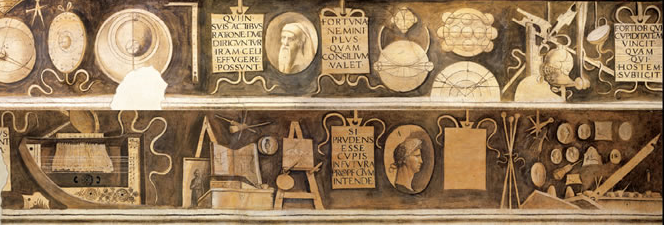
Fig. 1 Giorgione (?) Fresco depicting the liberal arts, ca. 1498-1499 or 1502-1503, detail. Castelfranco Veneto, Museo Casa Giorgione. The frieze unfolds over fifteen meters along the walls of the great room. Both the liberal arts (grammar, dialectic, rhetoric, geometry, arithmetic, astronomy and music) and the mechanical arts (war, agriculture, painting, sculpture and architecture) are represented.
The rhetorical antagonism between the arts was rooted in the painters’ pretension to defy the canvas constraints and portray the world as faithfully as possible. Sculptors claimed their superiority over painters emphasising their art’s three-dimensionality and accused them of being more concerned with tricking the eye rather than capturing the true essence of things. However, Leonardo cunningly turned this argument around: would not the ability of painting to conjure up such powerful illusions rather be a sign of its preeminence? Sculpture, enabling multiple viewpoints, could probably render human bodies more truthfully and aspire to eternity due to its medium’s durability. But who could contest painting’s ability to depict flesh tones, blood, transparency, the atmospheric traits of a scene, and the glow in lovers’ eyes? As an ardent defender of his métier, Leonardo sought to release painting from its seat among the mechanical arts and place it in a more privileged position. In the light of modern activism, we could regard him as an unwavering advocate of St. Luke’s followers and their practice. He argued that painters were endowed with “fatica d’ingegno” (mental exertion), therefore introducing a clear distinction with the allegedly more elementary “fatica corporale” (physical exertion), which in his view, was a signature of sculptors’ working routine.
Benedetto Varchi and his art opinion poll
Christiane Hessler[2] tells us that on March 1547, the historian, poet and philologist Benedetto Varchi, held two lectures on the Paragone at the Accademia Fiorentina. Attached to the publication of his conclusions (Due Lezzioni, 1549), he included the results of an opinion poll conducted among notable academics from both professions.
Varchi consulted the painters Pontormo, Bronzino and Vasari, and the sculptors Cellini, Tribolo, Sangallo and Tasso; Michelangelo wore two hats as painter and sculptor. Viewpoints ranged from the vitriolic in the case of Cellini to the more moderate opinions of Tasso and Bronzino, who even conceded some benefits to the other camp. But only the universal genius of Michelangelo came to a genuinely Solomonic judgement. He believed that both arts’ appreciation hinged on the crucial concept of relief rendering (rilievo)-a criterion disputed by both parties. For Michelangelo, to strive for the most faithful “rilievo” should be painting’s unquestionable attribute, while that of sculpture should be to attain the greatest possible deviation from painting’s flatness.
In principle, this argument could have solved the conundrum, as it enthroned both counterfeit and real relief as legitimate triumphs in each discipline. However, despite this apparent truce, the case was far from being dropped. Nobody alluded in the letters to the central argument brought forward by Leonardo- the opposition between “fatica corporale” and “fatica d’ingegno”. However, sculptors reasoned that they were not allowed to make mistakes when chiselling the stone, and therefore, their métier entailed a higher level of difficulty. Colossal statues carved out of a single stone block were incontestable evidence favouring sculpture’s predominance. To give a lethal blow to painters’ ambitions, Cellini unearthed the argument of the diversity of viewpoints and concluded that paintings offered the viewer only a meagre two sides.
Painters, for example, Bronzino, did not remain indifferent towards this criticism and picked up the gauntlet. As Christiane Hessler suggests, Bronzino’s portrait of the Medici court dwarf Morgante could be interpreted in this context as an ironic reply to Cellini: by showing both front and rear side views of this character, Bronzino, who got embroiled in the Paragone dispute, might have taken sides with his colleagues, mocking himself of sculpture’s presumed supremacy (Fig. 2).
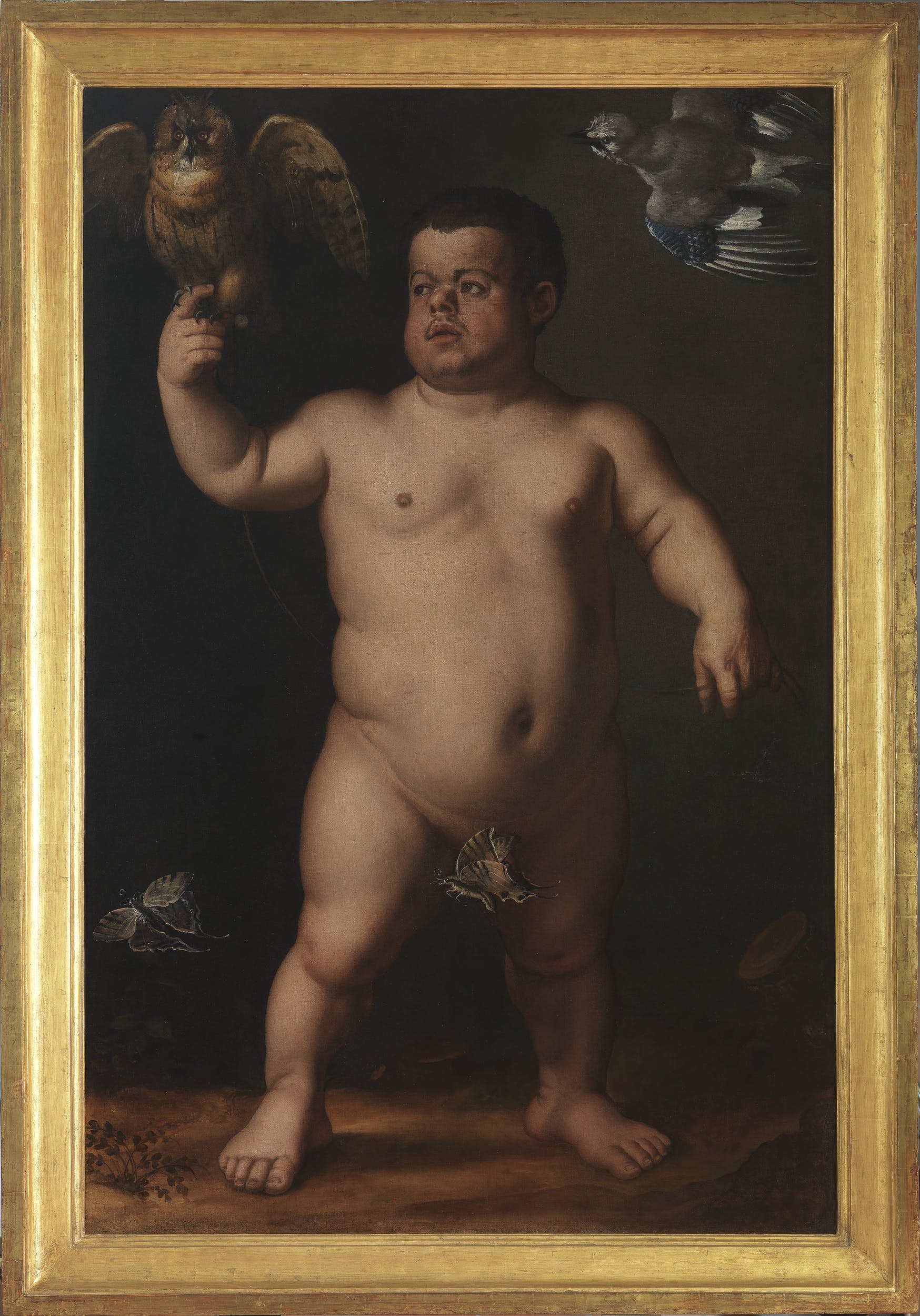
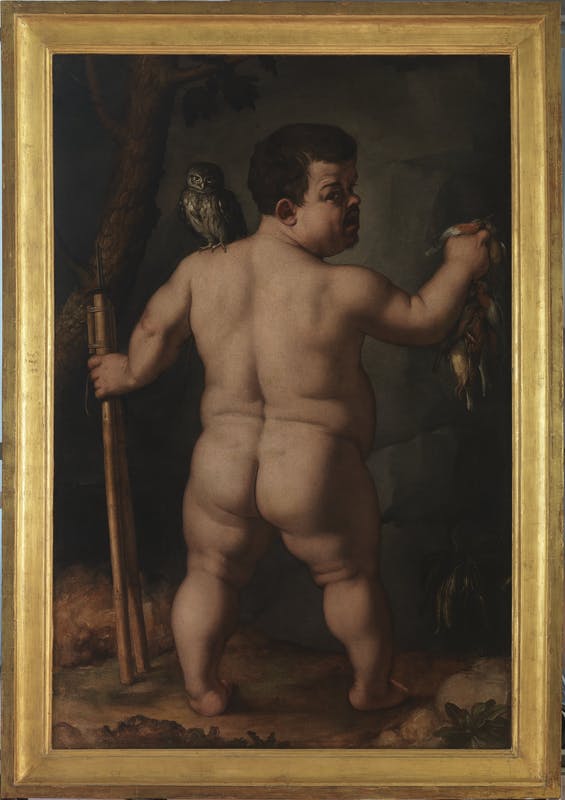
Fig. 2 Agnolo Bronzino, “Ritratto del Nano Morgante”, ca. 1553, Palazzo Pitti, Florence, Italy.
In 1563 Cosimo de’ Medici founded the Accademia dell’ Arti e del Disegno in Florence, following the advice of Giorgio Vasari. At that time, the reconciliation between the arts seemed to be more feasible than ever before. Under the tutelage of drawing (disegno), the shared stem from which architecture, painting and sculpture sprang, all visual arts were now reunited under the auspices of Minerva (Fig. 3).
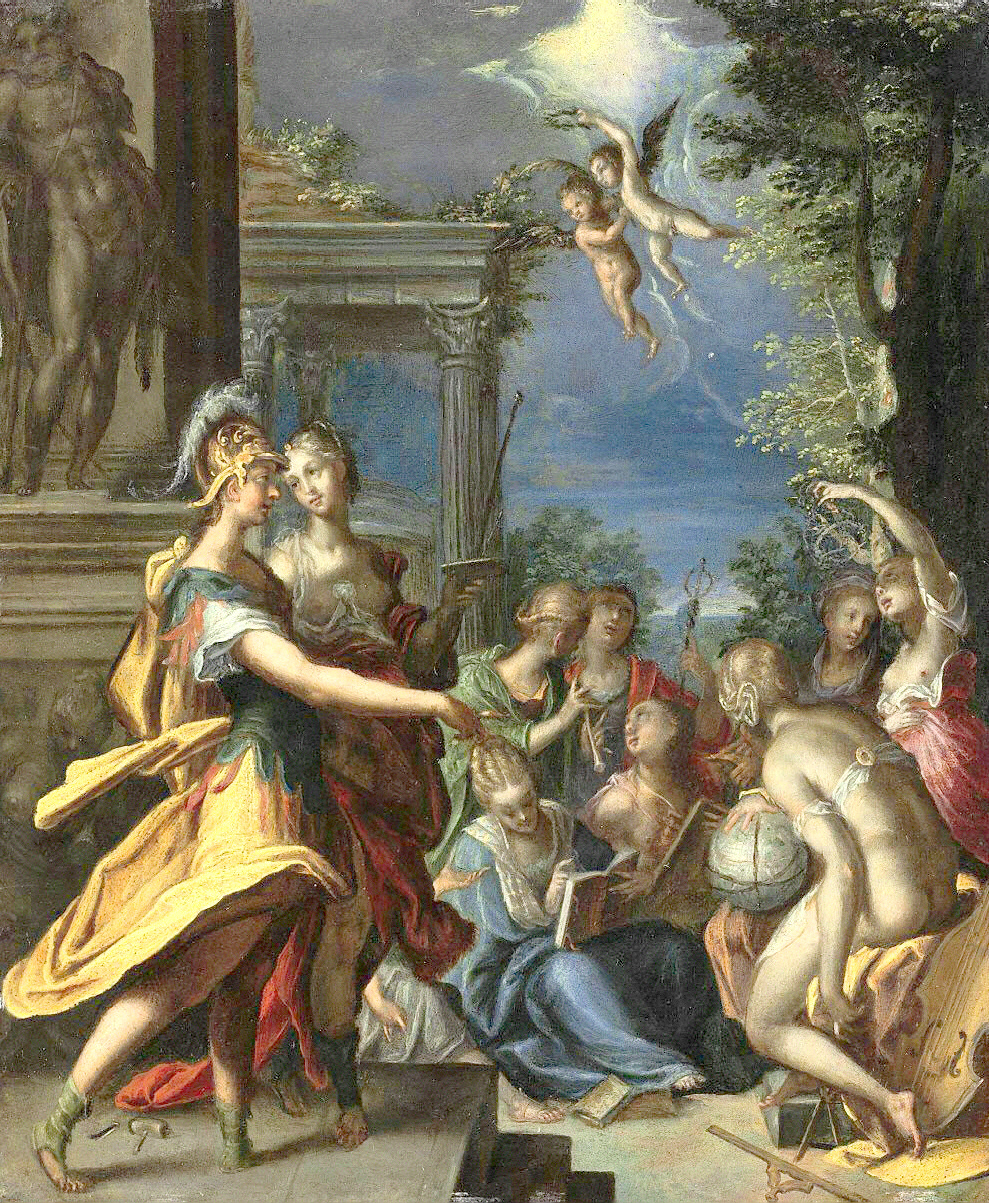
Fig. 3 Attributed to Hans von Aachen – Minerva introducing “Painting” to the Seven Liberal Arts.
Nevertheless, the whole affaire would flare up again in the following year during Michelangelo’s state funerals in Florence. The artist’s body had to be smuggled in a cart full of clothes and other merchandise from Rome, where he had been living since the 1530s as a political dissident after feeling disenchanted with Alessandro de’ Medici’s regime. Cosimo de’ Medici decided to stamp out the smouldering embers by entrusting two sculptors (Cellini and Ammanati) and two painters (Vasari and Bronzino) with the monumental tomb’s design.
It was decided that all the disciplines in which Michelangelo had excelled-painting, sculpture and architecture- should be represented by an allegorical figure. Although the idea was to provide a balanced celebration of Michelangelo’s talents, the discussion on the position of each of those figures quickly escalated. In the end, it was the allegory of sculpture that took the central place, flanked by the representations of painting and architecture (Fig. 4).
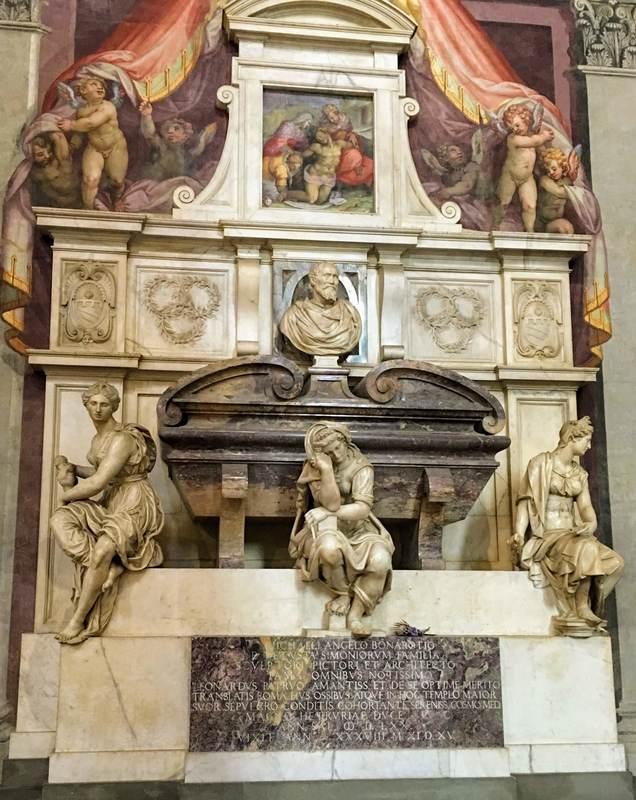
Fig. 4 Michelangelo’s tomb at the Church of Santa Croce, Florence, Italy. Designed by Giorgio Vasari with sculptures by Valerio Cioli, Giovanni Bandini and Battista Lorenzi.
The idea that various artistic disciplines could be compared and ranked was not limited to sculpture and painting, and it became the motive of many heated discussions even years after Michelangelo’s death. This competition was obviously never decided in favour of any of the contenders, and from today’s perspective, the whole exercise might seem pointless to us. Nevertheless, it was an incentive for artists to question the limits of their art and motivate them to challenge those limits and reach new artistic heights.
References
[1] Kohle, Hubertus (1989): Ut pictura poesis non erit. Denis Diderots Kunstbegriff. Studien zur Kunstgeschichte, Bd. 52. Hildesheim, New York: Olms.
[2] Christiane Hessler, “Maler und Bildhauer im sophistischen Tauziehen“ in Wettstreit der Künste. Malerei und Skulptur von Dürer bis Daumier. Edited by Ekkehard Mai und Kurt Wettengl. Catalogue of the exhibition held at Haus der Kunst München (1. February-5. May 2002) and at the Wallraf-Richartz- Museum, Fondation Corboud, Köln (25. May-25. August 2002). Wolfratshausen: Edition Minerva, 2002.









